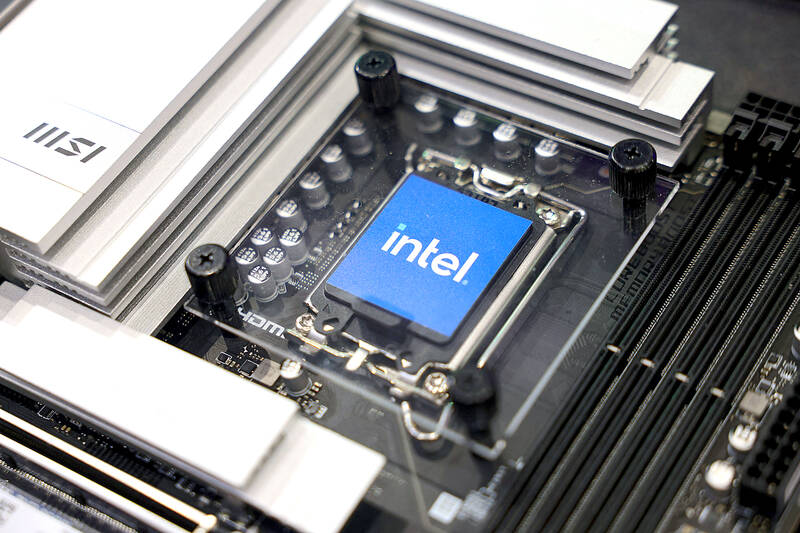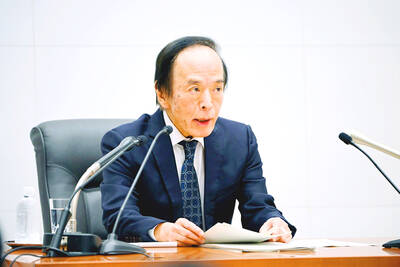Intel Corp is to spin off assets that are not central to its mission and create new products including custom semiconductors to try to better align itself with customers,
chief executive officer Lip-Bu Tan (陳立武) said on Monday.
The US chipmaker needs to replace the engineering talent it has lost, improve its balance sheet and better attune manufacturing processes to meet the needs of potential customers, Tan said.

Photo: I-Hwa Cheng, AFP
Speaking at his first public appearance as CEO, at the Intel Vision conference in Las Vegas, Tan did not specify what parts of Intel he believes are no longer central to its future.
“We have a lot of hard work ahead,” he said, addressing the company’s customers in the audience. “There are areas where we’ve fallen short of your expectations.”
The veteran semiconductor executive is trying to restore the fortunes of a company that dominated an industry for decades, but now finds itself chasing rivals in most of the areas that define success in the field. A key question confronting its leadership is whether a turnaround is best served by the company remaining whole or splitting up its key product and manufacturing operations.
Tan gave no indication that he would seek to divest either part of Intel. Instead, he highlighted the problems he needs to fix to get both units performing more successfully.
Intel’s chips for data center and artificial intelligence (AI)-related work in particular are not good enough, he said.
“We fell behind on innovation,” he said. “We have been too slow to adapt and meet your needs.”
Tan, 65, assumed the role on March 18. He had been an Intel board member before stepping down in August last year.
The CEO said he has been asked why he took on the job this late in his career.
“It was very hard for me to see it struggle,” Tan said. “I simply could not stay on the sidelines knowing that I could help.”
Tan’s predecessor, Pat Gelsinger, was pushed out by the board for a perceived failure to rejuvenate Intel’s product lineup. One of the most glaring challenges: creating an AI accelerator chip to rival the products of Nvidia Corp. That company, once in Intel’s shadow, has seen its revenue and valuation skyrocket over the past two years due to the AI computing boom.
Gelsinger had also set out to turn Intel into a chip foundry — a contract manufacturer that makes products for outside clients — but that effort is still in its early stages.
Tan said the company needs to listen to prospective outside customers for its factories and let them specify the design and manufacture of their products, rather than Intel dictating the way it would be done.
He said many large customers want custom parts — and his company will do it for them.
The CEO repeatedly emphasized that there is no quick fix to Intel’s problems, but that he is committed to staying at the company as long as it takes.
“It won’t happen overnight, but I know we can get there,” he said.

Taiwan Semiconductor Manufacturing Co (TSMC, 台積電) last week recorded an increase in the number of shareholders to the highest in almost eight months, despite its share price falling 3.38 percent from the previous week, Taiwan Stock Exchange data released on Saturday showed. As of Friday, TSMC had 1.88 million shareholders, the most since the week of April 25 and an increase of 31,870 from the previous week, the data showed. The number of shareholders jumped despite a drop of NT$50 (US$1.59), or 3.38 percent, in TSMC’s share price from a week earlier to NT$1,430, as investors took profits from their earlier gains

In a high-security Shenzhen laboratory, Chinese scientists have built what Washington has spent years trying to prevent: a prototype of a machine capable of producing the cutting-edge semiconductor chips that power artificial intelligence (AI), smartphones and weapons central to Western military dominance, Reuters has learned. Completed early this year and undergoing testing, the prototype fills nearly an entire factory floor. It was built by a team of former engineers from Dutch semiconductor giant ASML who reverse-engineered the company’s extreme ultraviolet lithography (EUV) machines, according to two people with knowledge of the project. EUV machines sit at the heart of a technological Cold

TAIWAN VALUE CHAIN: Foxtron is to fully own Luxgen following the transaction and it plans to launch a new electric model, the Foxtron Bria, in Taiwan next year Yulon Motor Co (裕隆汽車) yesterday said that its board of directors approved the disposal of its electric vehicle (EV) unit, Luxgen Motor Co (納智捷汽車), to Foxtron Vehicle Technologies Co (鴻華先進) for NT$787.6 million (US$24.98 million). Foxtron, a half-half joint venture between Yulon affiliate Hua-Chuang Automobile Information Technical Center Co (華創車電) and Hon Hai Precision Industry Co (鴻海精密), expects to wrap up the deal in the first quarter of next year. Foxtron would fully own Luxgen following the transaction, including five car distributing companies, outlets and all employees. The deal is subject to the approval of the Fair Trade Commission, Foxtron said. “Foxtron will be

INFLATION CONSIDERATION: The BOJ governor said that it would ‘keep making appropriate decisions’ and would adjust depending on the economy and prices The Bank of Japan (BOJ) yesterday raised its benchmark interest rate to the highest in 30 years and said more increases are in the pipeline if conditions allow, in a sign of growing conviction that it can attain the stable inflation target it has pursued for more than a decade. Bank of Japan Governor Kazuo Ueda’s policy board increased the rate by 0.2 percentage points to 0.75 percent, in a unanimous decision, the bank said in a statement. The central bank cited the rising likelihood of its economic outlook being realized. The rate change was expected by all 50 economists surveyed by Bloomberg. The